

Even so, the Traffic Police (TP) will not rest on its laurels, continuously seeking ways to improve general road safety while aiming to reduce and clamp down the increase of some traffic offences. These offences are usually caused by reckless and erratic road users, who are endangering their own lives and other users.
With the aid of Psychology, more specifically Reinforcement and Punishment, this can further assist the TP in promoting road safety and ensuring that the roads become safer for all users.
Reference
Annual Road Traffic Situation 2019
. What is Operant Conditioning?
What Is Operant Conditioning and How Does It Work?
Operant conditioning, sometimes referred to as instrumental conditioning, is a method of learning that employs rewards and punishments for behavior.
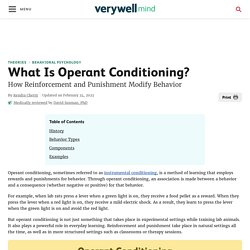
Through operant conditioning, an association is made between a behavior and a consequence (whether negative or positive) for that behavior.1 For example, when lab rats press a lever when a green light is on, they receive a food pellet as a reward. When they press the lever when a red light is on, they receive a mild electric shock. As a result, they learn to press the lever when the green light is on and avoid the red light. What is Reinforcement and Punishment? Operant conditioning: Positive-and-negative reinforcement and punishment. Learning: Negative Reinforcement vs. Punishment. Reinforcement. Positive Reinforcement and Operant Conditioning. In operant conditioning, positive reinforcement involves the addition of a reinforcing stimulus following a behavior that makes it more likely that the behavior will occur again in the future.

When a favorable outcome, event, or reward occurs after an action, that particular response or behavior will be strengthened. One of the easiest ways to remember positive reinforcement is to think of it as something being added. By thinking of it in these terms, you may find it easier to identify real-world examples of positive reinforcement. Sometimes positive reinforcement occurs quite naturally. For example, when you hold the door open for someone you might receive praise and a thank you. Negative Reinforcement and Operant Conditioning.
Negative reinforcement is a term described by B.
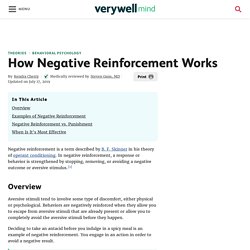
F. Oct2019 singapore traffic police officers stop and reward riders whom suited up when riding. Punishment. Positive Punishment and Operant Conditioning. Positive punishment is a concept used in B.F.

Skinner's theory of operant conditioning. How exactly does the positive punishment process work? The goal of any type of punishment is to decrease the behavior that it follows. In the case of positive punishment, it involves presenting an unfavorable outcome or event following an undesirable behavior. When the subject performs an unwanted action, some type of negative outcome is purposefully applied. The concept of positive punishment can be difficult to remember, especially because it seems like a contradiction.
Examples You may be surprised to notice examples of positive punishment in your day-to-day life. Because you're late to work one morning, you drive over the speed limit through a school zone. How Negative Punishment Works. Negative punishment is an important concept in B.
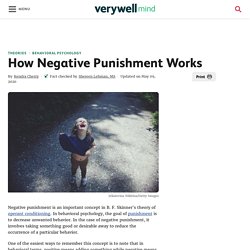
F. Skinner's theory of operant conditioning. In behavioral psychology, the goal of punishment is to decrease unwanted behavior. In the case of negative punishment, it involves taking something good or desirable away to reduce the occurrence of a particular behavior. One of the easiest ways to remember this concept is to note that in behavioral terms, positive means adding something while negative means taking something away. Strengthening Deterrence Against Irresponsible Driving. ACT roads: Speed limits obeyed through positive reinforcement. News, act-politics, speed, smiley signs, road safety In Sweden if you drive under the speed limit, a traffic camera snaps your vehicle and enters you in a lottery where the prizes are funded by drivers who speed.
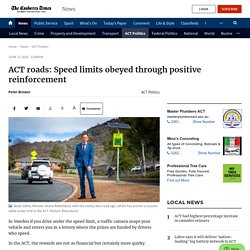
In the ACT, the rewards are not as financial but certainly more quirky. Based on an idea trialled in NSW, the ACT is rolling out its "smiley face" driver reward program. Rewarding safe drivers could make roads safer. Insurance schemes that reward safe drivers with lower premiums can actually help prevent accidents, according to a report from the Swedish National Road and Transport Research Institute (VTI).

“Pricing of car insurance that is aimed at rewarding safe traffic behaviour can help limit the number of accidents,” the VTI reports in a press release. The report proposes giving insurance companies access to police records of individual traffic offences and crimes - a suggestion that not surprisingly is controversial. In Norway drivers have been made to toe the line since 2004 with a system that assigns penalty points to driver’s licenses for various offences.
If a driver gets too many of these black marks within a certain period, he or she can lose his or her license. Perhaps penalty points could also cause a driver’s insurance premiums to go up. Bigger risk The more a driver breaks traffic regulations, the greater the odds that he or she will be involved in an accident. Knowledge would help. Seminar 3 at CCNY » Punishment as a device for accident prevention. Deterrent effects of traffic enforcement. From the very beginning of road traffic history people understood that without any laws or regulations, all movement on the roads would be in the so-called “state of nature,” which means that the molecules within an environment, represented as cars on the city streets, would be in constant and uncontrolled motion, allowing for random collisions and accidents.

The existence of this traffic’s tendency towards chaos contributed to the evolution of traffic environment – first traffic legislation, the “Locomotive on Highways Act”, was adopted by the British Parliament in 1861 and limited the weight of allowed vehicles to 12 tons as well as imposed a 10 mph speed limit (Ross, 1993). Furthermore, more and more elements and control devices have been added to the system, including first license plates in France in 1893, first driver license in the U.K. in 1904, and the first traffic light in Ohio in 1914 (Legge et al., 1993).
Figure 3: “Portrait of a man begging for trouble. Porter, Lauren. Does Punishing Speeders Prevent Speeding? – Association for Psychological Science – APS. Speeding leads to more car accidents worldwide than almost any other behavior behind the wheel.
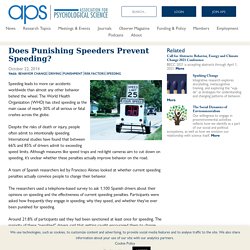
The World Health Organization (WHO) has cited speeding as the main cause of nearly 30% of all serious or fatal crashes across the globe. Despite the risks of death or injury, people often admit to intentionally speeding. International studies have found that between 66% and 85% of drivers admit to exceeding speed limits. Although measures like speed traps and red-light cameras aim to cut down on speeding, it’s unclear whether these penalties actually improve behavior on the road.
A team of Spanish researchers led by Francisco Alonso looked at whether current speeding penalties actually convince people to change their behavior. The researchers used a telephone-based survey to ask 1,100 Spanish drivers about their opinions on speeding and the effectiveness of current speeding penalties. Around 21.8% of participants said they had been sanctioned at least once for speeding. The difference between classical and operant conditioning - Peggy Andover.